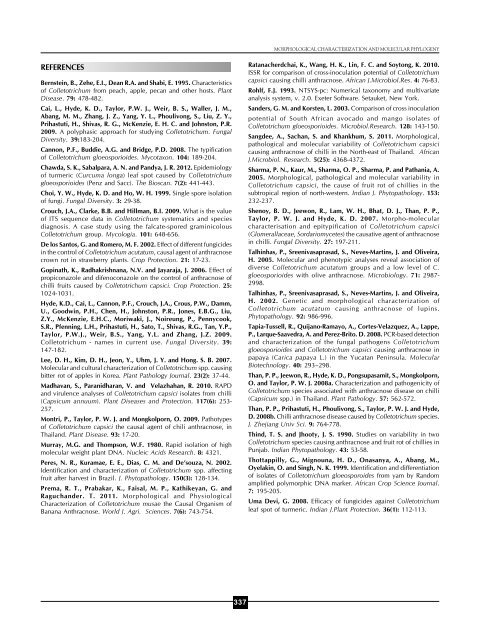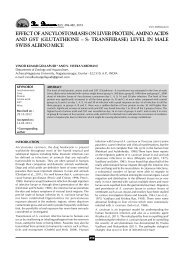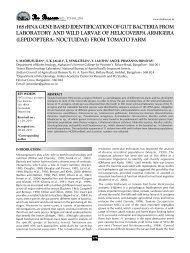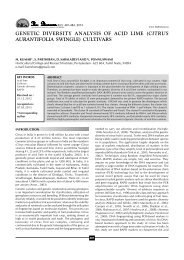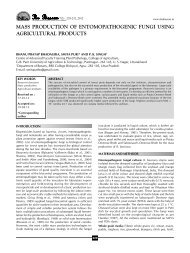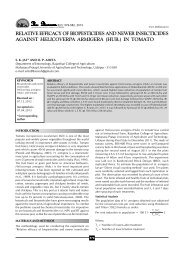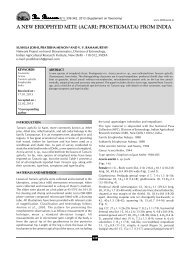Morphological characterization and molecular ... - THE BIOSCAN
Morphological characterization and molecular ... - THE BIOSCAN
Morphological characterization and molecular ... - THE BIOSCAN
- No tags were found...
Create successful ePaper yourself
Turn your PDF publications into a flip-book with our unique Google optimized e-Paper software.
MORPHOLOGICAL CHARACTERIZATION AND MOLECULAR PHYLOGENYREFERENCESBernstein, B., Zehe, E.I., Dean R.A. <strong>and</strong> Shabi, E. 1995. Characteristicsof Colletotrichum from peach, apple, pecan <strong>and</strong> other hosts. PlantDisease. 79: 478-482.Cai, L., Hyde, K. D., Taylor, P.W. J., Weir, B. S., Waller, J. M.,Abang, M. M., Zhang, J. Z., Yang, Y. L., Phoulivong, S., Liu, Z. Y.,Prihastuti, H., Shivas, R. G., McKenzie, E. H. C. <strong>and</strong> Johnston, P.R.2009. A polyphasic approach for studying Colletotrichum. FungalDiversity. 39:183-204.Cannon, P.F., Buddie, A.G. <strong>and</strong> Bridge, P.D. 2008. The typificationof Colletotrichum gloeosporioides. Mycotaxon. 104: 189-204.Chawda, S. K., Sabalpara, A. N. <strong>and</strong> P<strong>and</strong>ya, J. R. 2012. Epidemiologyof turmeric (Curcuma longa) leaf spot caused by Colletotrichumgloeosporioides (Penz <strong>and</strong> Sacc). The Bioscan. 7(2): 441-443.Choi, Y. W., Hyde, K. D. <strong>and</strong> Ho, W. H. 1999. Single spore isolationof fungi. Fungal Diversity. 3: 29-38.Crouch, J.A., Clarke, B.B. <strong>and</strong> Hillman, B.I. 2009. What is the valueof ITS sequence data in Colletotrichum systematics <strong>and</strong> speciesdiagnosis. A case study using the falcate-spored graminicolousColletotrichum group. Mycologia. 101: 648-656.De los Santos, G. <strong>and</strong> Romero, M. F. 2002. Effect of different fungicidesin the control of Colletotrichum acutatum, causal agent of anthracnosecrown rot in strawberry plants. Crop Protection. 21: 17-23.Gopinath, K., Radhakrishnana, N.V. <strong>and</strong> Jayaraja, J. 2006. Effect ofpropiconazole <strong>and</strong> difenoconazole on the control of anthracnose ofchilli fruits caused by Colletotrichum capsici. Crop Protection. 25:1024-1031.Hyde, K.D., Cai, L., Cannon, P.F., Crouch, J.A., Crous, P.W., Damm,U., Goodwin, P.H., Chen, H., Johnston, P.R., Jones, E.B.G., Liu,Z.Y., McKenzie, E.H.C., Moriwaki, J., Noireung, P., Pennycook,S.R., Pfenning, L.H., Prihastuti, H., Sato, T., Shivas, R.G., Tan, Y.P.,Taylor, P.W.J., Weir, B.S., Yang, Y.L. <strong>and</strong> Zhang, J.Z. 2009.Colletotrichum - names in current use. Fungal Diversity. 39:147-182.Lee, D. H., Kim, D. H., Jeon, Y., Uhm, J. Y. <strong>and</strong> Hong. S. B. 2007.Molecular <strong>and</strong> cultural <strong>characterization</strong> of Colletotrichum spp. causingbitter rot of apples in Korea. Plant Pathology Journal. 23(2): 37-44.Madhavan, S., Paranidharan, V. <strong>and</strong> Velazhahan, R. 2010. RAPD<strong>and</strong> virulence analyses of Colletotrichum capsici isolates from chilli(Capsicum annuum). Plant Diseases <strong>and</strong> Protection. 117(6): 253-257.Montri, P., Taylor, P. W. J. <strong>and</strong> Mongkolporn, O. 2009. Pathotypesof Colletotrichum capsici the causal agent of chili anthracnose, inThail<strong>and</strong>. Plant Disease. 93: 17-20.Murray, M.G. <strong>and</strong> Thompson, W.F. 1980. Rapid isolation of high<strong>molecular</strong> weight plant DNA. Nucleic Acids Research. 8: 4321.Peres, N. R., Kuramae, E. E., Dias, C. M. <strong>and</strong> De’souza, N. 2002.Identification <strong>and</strong> <strong>characterization</strong> of Colletotrichum spp. affectingfruit after harvest in Brazil. J. Phytopathology. 150(3): 128-134.Prema, R. T., Prabakar, K., Faisal, M. P., Kathikeyan, G. <strong>and</strong>Raguch<strong>and</strong>er. T. 2011. <strong>Morphological</strong> <strong>and</strong> PhysiologicalCharacterization of Colletotrichum musae the Causal Organism ofBanana Anthracnose. World J. Agri. Sciences. 7(6): 743-754.Ratanacherdchai, K., Wang, H. K., Lin, F. C. <strong>and</strong> Soytong, K. 2010.ISSR for comparison of cross-inoculation potential of Colletotrichumcapsici causing chilli anthracnose. African J.Microbiol.Res. 4: 76-83.Rohlf, F.J. 1993. NTSYS-pc: Numerical taxonomy <strong>and</strong> multivariateanalysis system, v. 2.0. Exeter Software. Setauket, New York.S<strong>and</strong>ers, G. M. <strong>and</strong> Korsten, L. 2003. Comparison of cross inoculationpotential of South African avocado <strong>and</strong> mango isolates ofColletotrichum gloeosporioides. Microbiol.Research. 128: 143-150.Sangdee, A., Sachan, S. <strong>and</strong> Khankhum, S. 2011. <strong>Morphological</strong>,pathological <strong>and</strong> <strong>molecular</strong> variability of Colletotrichum capsicicausing anthracnose of chilli in the North-east of Thail<strong>and</strong>. AfricanJ.Microbiol. Research. 5(25): 4368-4372.Sharma, P. N., Kaur, M., Sharma, O. P., Sharma, P. <strong>and</strong> Pathania, A.2005. <strong>Morphological</strong>, pathological <strong>and</strong> <strong>molecular</strong> variability inColletotrichum capsici, the cause of fruit rot of chillies in thesubtropical region of north-western. Indian J. Phytopathology. 153:232-237.Shenoy, B. D., Jeewon, R., Lam, W. H., Bhat, D. J., Than, P. P.,Taylor, P. W. J. <strong>and</strong> Hyde, K. D. 2007. Morpho-<strong>molecular</strong>characterisation <strong>and</strong> epitypification of Colletotrichum capsici(Glomerallaceae, Sordariomycetes) the causative agent of anthracnosein chilli. Fungal Diversity. 27: 197-211.Talhinhas, P., Sreenivasaprasad, S., Neves-Martins, J. <strong>and</strong> Oliveira,H. 2005. Molecular <strong>and</strong> phenotypic analyses reveal association ofdiverse Colletotrichum acutatum groups <strong>and</strong> a low level of C.gloeosporioides with olive anthracnose. Microbiology. 71: 2987-2998.Talhinhas, P., Sreenivasaprasad, S., Neves-Martins, J. <strong>and</strong> Oliveira,H. 2002. Genetic <strong>and</strong> morphological <strong>characterization</strong> ofColletotrichum acutatum causing anthracnose of lupins.Phytopathology. 92: 986-996.Tapia-Tussell, R., Quijano-Ramayo, A., Cortes-Velazquez, A., Lappe,P., Larque-Saavedra, A. <strong>and</strong> Perez-Brito. D. 2008. PCR-based detection<strong>and</strong> <strong>characterization</strong> of the fungal pathogens Colletotrichumgloeosporioides <strong>and</strong> Colletotrichum capsici causing anthracnose inpapaya (Carica papaya L.) in the Yucatan Peninsula. MolecularBiotechnology. 40: 293–298.Than, P. P., Jeewon, R., Hyde, K. D., Pongsupasamit, S., Mongkolporn,O. <strong>and</strong> Taylor, P. W. J. 2008a. Characterization <strong>and</strong> pathogenicity ofColletotrichum species associated with anthracnose disease on chilli(Capsicum spp.) in Thail<strong>and</strong>. Plant Pathology. 57: 562-572.Than, P. P., Prihastuti, H., Phoulivong, S., Taylor, P. W. J. <strong>and</strong> Hyde,D. 2008b. Chilli anthracnose disease caused by Colletotrichum species.J. Zhejiang Univ Sci. 9: 764-778.Thind, T. S. <strong>and</strong> Jhooty, J. S. 1990. Studies on variability in twoColletotrichum species causing anthracnose <strong>and</strong> fruit rot of chillies inPunjab. Indian Phytopathology. 43: 53-58.Thottappilly, G., Mignouna, H. D., Onasanya, A., Abang, M.,Oyelakin, O. <strong>and</strong> Singh, N. K. 1999. Identification <strong>and</strong> differentiationof isolates of Colletotrichum gloeosporoides from yam by R<strong>and</strong>omamplified polymorphic DNA marker. African Crop Science Journal.7: 195-205.Uma Devi, G. 2008. Efficacy of fungicides against Colletotrichumleaf spot of turmeric. Indian J.Plant Protection. 36(1): 112-113.337


